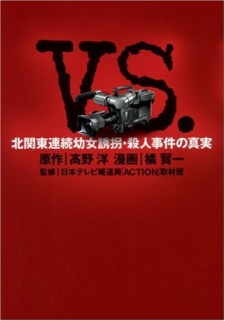Apr 14, 2019
Introduction:
VS - Kitakantou Renzoku Youjo Yuukai Satsujin Jiken no Shinjitsu is a resounding success in the three endeavors it undertakes. It is simultaneoulsy:
- a potent example of how innocents can be wrongly convicted and culprits not caught, allowing the crimes to continue taking place,
- a testament to the importance of journalism in modern society, and
- a vibrant example of the necessity to stay determined when everyone and everything is seemingly set to make you fail.
This manga tells the true story of NTV journalist Kiyoshi Shimizu and his team as they study the cases of the rape and murder of five young girls between 4 and
...
8 years old, all committed within a radius of 10 km between 1979 and 1996.
I'll be using VS as short for VS - Kitakantou Renzoku Youjo Yuukai Satsujin Jiken no Shinjitsu throughout this review.
Story:
In an effort to create interest in their TV programs, NTV (under the name of NNN for Nippon News Network in the manga) gives five teams of journalists carte blanche to investigate and report on five phenomenons that currently inflluence the lives of the Japanese.
The generic name of the program is "Action: the projects that shake Japan up", and while other teams choose safer and more ordinary topics like the false labelinig of food products or the indadequate handling of waste, Shimizu chooses to investigate on the series of abductions and murders of little girls in Kita-Kanto.
He and his team discover discrepancies in the police reports about the incidents, and conclude that the crimes have all been committed by the same person. Considering that one of the murders was committed after the man suspected to have committed the fourth murder was imprisoned, he is innocent and the culprit still roaming free. Over two years of investigation, the journalists, through inventive methods, prove the innocence of Sugaya, the imprisoned suspect, and in the end he is freed and the police as well as the journalists start looking for the real culprit.
Why it matters:
To me, the appeal of this manga comes in no small part from how well it shows just how much journalism can accomplish.
It shows how journalists are capable of changing a country/society through taking initiatives of their own instead of simply redistributing official announcements. It shows how journalists can reveal the negligence and corruption of police, as well as their withholding of information that contradicts the narrative they have to push, and how this all leads to wrong conclusions. But VS also shows how the policemen are pressured into capturing suspects and obtaining confessions. One of this manga's strengths is that it does not try to put the whole blame on one group of people, it paints a comprehensive picture that shows how the whole judiciary system is misguided. And the unfariness of the Japanese judiciary system is a highly topical issue, as the Carlos Ghosn case has recently shown, making this manga more relevant than ever. As Mr Shimizu himself puts it, in Japan "all accusations of miscarriage of justice are stigmatized, even though the system gives an enormous importance to confessions," which are rather unreliable.
This manga also shows how journalism allows to correct the conclusions of wrongly resolved cases, and make the court and police own up to their mistakes and create laws to prevent such mistakes from being made again.
It shows how journalists can complement the work of the police to find culprits, and how a journalist can restore a suspect's honor and enable them to live somewhat normally again after being freed from jail.
And perhaps most importantly, this manga shows that in a free society, public opinion is an unassailable force, and since journalism has the power to influence it by revealing information, journalism is an incredibly powerful instrument in opposing the government's power when necessary.
Through the telling of a true story, VS paints a nuanced and realistic portrait of journalism. It is conspicuous that it was made in close collaboration with the journalists in charge of this case, as the careful and precise analysis it presents would not have been possible otherwise.
If you are interested in knowing how to obtain information as a journalist, you will no doubt be pleased to discover that this manga also shows the appropriate approach to do so. For example, crucial information is obtained by Shimizu through Mami's mother (Mami is the fourth victim), after he has built trust between her and her family and him and his team, making it possible for her to open up and speak in front of the camera.
Thus, I believe that anyone interested in journalism, the dysfunctional Japanese judiciary system or looking for something original to read, has a lot to gain from reading this one-shot. Although it is somewhat heavy-handed at times, it is gripping throughout and an important read.
At the end of the manga, you can find the dossier which I've quoted on multiple occasions in this review and in which Mr. Sugaya, Mr. Shimizu and Mrs. Sugimuto discuss the adaptation of the case into a manga, the way Sugaya was forced to confess to a crime he didn't commmit, how the japanese judiciary system is built to find not the truth but culprits, how journalism has helped change that and what to learn from this case. It helps make the reader realize that the entire story is true, and provides some additional interesting information, which is why it's also worth reading.
P.S.: this is a repost of my review on AniList, not plagiarism.
Reviewer’s Rating: 9
What did you think of this review?
Nice
 0
0
Love it
 0
0
Funny
 0
0
Confusing
 0
0
Well-written
 0
0
Creative
 0
0Show all



















